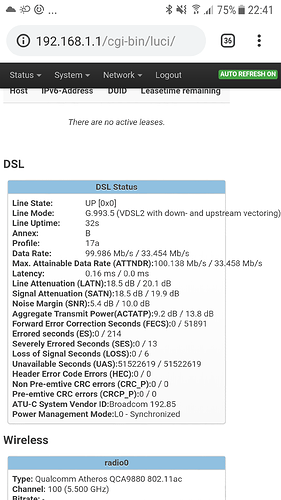Hi,
I need help. I tried severel diffrent Lantiq-Firmware on 2 diffrent devices. Unfortunately I can't get more data rate than 70 Mbit/s with all Bt5 devices. With my old EasyBox 904 I got 95 Mbit/s for downstream and also 33 Mbit/s upstream insted of 22 Mbit/s now.
Here are several results of diffrent used Firmware-Versions:
used Firmware: vectoring-vdsl.bin
root@OpenWrt:~# /etc/init.d/dsl_control status
ATU-C Vendor ID: Broadcom 192.85
ATU-C System Vendor ID: Broadcom
Chipset: Lantiq-VRX200
Firmware Version: 5.7.5.6.1.7
API Version: 4.17.18.6
XTSE Capabilities: 0x0, 0x0, 0x0, 0x0, 0x0, 0x0, 0x0, 0x2
Annex: B
Line Mode: G.993.5 (VDSL2 with down- and upstream vectoring)
Profile: 17a
Line State: UP [0x801: showtime_tc_sync]
Forward Error Correction Seconds (FECS): Near: 0 / Far: 1
Errored seconds (ES): Near: 0 / Far: 6996
Severely Errored Seconds (SES): Near: 0 / Far: 19
Loss of Signal Seconds (LOSS): Near: 0 / Far: 10
Unavailable Seconds (UAS): Near: 14804826 / Far: 14804826
Header Error Code Errors (HEC): Near: 0 / Far: 0
Non Pre-emtive CRC errors (CRC_P): Near: 0 / Far: 0
Pre-emtive CRC errors (CRCP_P): Near: 0 / Far: 0
Power Management Mode: L0 - Synchronized
Latency [Interleave Delay]: 0.18 ms [Fast] 0.0 ms [Fast]
Data Rate: Down: 69.990 Mb/s / Up: 22.997 Mb/s
Line Attenuation (LATN): Down: 18.6 dB / Up: 21.1 dB
Signal Attenuation (SATN): Down: 18.6 dB / Up: 21.1 dB
Noise Margin (SNR): Down: 10.2 dB / Up: 12.8 dB
Aggregate Transmit Power (ACTATP): Down: 9.3 dB / Up: 13.8 dB
Max. Attainable Data Rate (ATTNDR): Down: 94.244 Mb/s / Up: 29.068 Mb/s
Line Uptime Seconds: 175
Line Uptime: 2m 55s
root@OpenWrt:~#
used Firmware: dsl_vr9_firmware_xdsl-05.08.01.05.00.07_05.08.00.09.00.01.bin
root@OpenWrt:~# /etc/init.d/dsl_control status
ATU-C Vendor ID: Broadcom 192.85
ATU-C System Vendor ID: Broadcom
Chipset: Lantiq-VRX200
Firmware Version: 5.8.1.5.0.7
API Version: 4.17.18.6
XTSE Capabilities: 0x0, 0x0, 0x0, 0x0, 0x0, 0x0, 0x0, 0x2
Annex: B
Line Mode: G.993.5 (VDSL2 with down- and upstream vectoring)
Profile: 17a
Line State: UP [0x801: showtime_tc_sync]
Forward Error Correction Seconds (FECS): Near: 0 / Far: 0
Errored seconds (ES): Near: 0 / Far: 6997
Severely Errored Seconds (SES): Near: 0 / Far: 19
Loss of Signal Seconds (LOSS): Near: 0 / Far: 10
Unavailable Seconds (UAS): Near: 14804925 / Far: 14804925
Header Error Code Errors (HEC): Near: 0 / Far: 0
Non Pre-emtive CRC errors (CRC_P): Near: 0 / Far: 0
Pre-emtive CRC errors (CRCP_P): Near: 0 / Far: 0
Power Management Mode: L0 - Synchronized
Latency [Interleave Delay]: 0.18 ms [Fast] 0.0 ms [Fast]
Data Rate: Down: 69.990 Mb/s / Up: 22.997 Mb/s
Line Attenuation (LATN): Down: 18.6 dB / Up: 21.1 dB
Signal Attenuation (SATN): Down: 18.6 dB / Up: 21.2 dB
Noise Margin (SNR): Down: 12.1 dB / Up: 12.4 dB
Aggregate Transmit Power (ACTATP): Down: 9.3 dB / Up: 13.9 dB
Max. Attainable Data Rate (ATTNDR): Down: 91.031 Mb/s / Up: 28.584 Mb/s
Line Uptime Seconds: 25
Line Uptime: 25s
root@OpenWrt:~#
used Firmware: vr9-B-dsl.bin (AVM-Firmware extraction)
root@OpenWrt:~# /etc/init.d/dsl_control status
ATU-C Vendor ID: Broadcom 192.85
ATU-C System Vendor ID: Broadcom
Chipset: Lantiq-VRX200
Firmware Version: 5.9.0.12.1.7
API Version: 4.17.18.6
XTSE Capabilities: 0x0, 0x0, 0x0, 0x0, 0x0, 0x0, 0x0, 0x2
Annex: B
Line Mode: G.993.5 (VDSL2 with down- and upstream vectoring)
Profile: 17a
Line State: UP [0x801: showtime_tc_sync]
Forward Error Correction Seconds (FECS): Near: 0 / Far: 0
Errored seconds (ES): Near: 0 / Far: 6997
Severely Errored Seconds (SES): Near: 0 / Far: 19
Loss of Signal Seconds (LOSS): Near: 0 / Far: 10
Unavailable Seconds (UAS): Near: 14805017 / Far: 14805017
Header Error Code Errors (HEC): Near: 0 / Far: 0
Non Pre-emtive CRC errors (CRC_P): Near: 0 / Far: 0
Pre-emtive CRC errors (CRCP_P): Near: 0 / Far: 0
Power Management Mode: L0 - Synchronized
Latency [Interleave Delay]: 0.18 ms [Fast] 0.0 ms [Fast]
Data Rate: Down: 69.987 Mb/s / Up: 22.997 Mb/s
Line Attenuation (LATN): Down: 19.2 dB / Up: 21.1 dB
Signal Attenuation (SATN): Down: 19.2 dB / Up: 20.9 dB
Noise Margin (SNR): Down: 13.4 dB / Up: 12.8 dB
Aggregate Transmit Power (ACTATP): Down: 9.4 dB / Up: 13.9 dB
Max. Attainable Data Rate (ATTNDR): Down: 70.215 Mb/s / Up: 28.957 Mb/s
Line Uptime Seconds: 178
Line Uptime: 2m 58s
root@OpenWrt:~#
It seems the AVM-Firmware is even worse than all other versions. - I also tried to play with SNR offset. It seems that the problem is, my connection would also work with 6 dB down SNR and 10 dB up, but it doesn't make any diffrence if I set it on -3 dB or +3db or something else.

